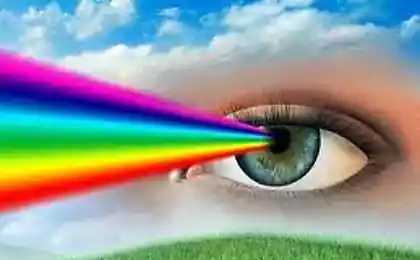506
The susceptibility of the square: why do some people see more than others
Sixty five million six hundred thirty six thousand three hundred forty eight
© Leta Sobierajski
We all perceive the surrounding world differently: someone who likes the disco lights and loud fireworks, and someone barely tolerate even watching the trailer for action-Packed film. Scientists have found that a quarter of the population of the planet is sensitive and captures the information coming through the senses, and it seems that it is this feature that creates talented composers and geniuses of cinema.
American writer pearl Buck, Nobel prize for literature, once said, "the truly creative mind in any field will be able to do more than expected. People are born abnormally, inhumanly sensitive. For him... a touch is a blow, a sound of thunder, bad luck, a tragedy, a joy is an ecstasy, a friend is like love, love — God, and the failure of such death. Add to this painfully fragile organizations a compelling need to create, create and create — because without the creation of music, poetry, books, buildings, or other meaningful things very breath torn away from him. Man must create, must pour out creation. For some strange, unexplained inner need, he does not feel alive, if not doing it."
In 1997 psychologists Elaine and Arthur Aaron (state University of new York at stony brook, USA) created the concept of a hypersensitive individual. The focus of their attention was people who have often shown a keen vosparenie the outside world and there are brightly outlined reaction to it. Spouse Aaron came to the conclusion that about 15-20% of the world population characterized by a heightened sensitivity to information received through the senses. The psyche of such people gets agitated due to sensory stimuli: the sharp smells, loud noises, bright lights, and strong taste. To measure the degree of sensory hypersensitivity (SSC), scientists have created a scale that consists of 27 rows. They found that the members of its upper stages usually get a very wide, varied and vivid experience of emotional reactions: for example, unable to cry in the bright sun, very much to fall in love or remember the dream alive more than other people.
After measuring the scale SC, experts from different countries and organizations have done a lot of research. The main conclusion was that human sensitivity actually has many degrees and shades. This range includes not only a touch sensitivity but also sensitivity narcissistic and moral. In the touch area psychologist centre Hamilton Health Sciences (Canada), Dr. Kathie of Smolewska together with a group of colleagues have found three types of sensitivity which are placed in the scale of Aaron: "excitable", "low sensory threshold" and "aesthetically sensitive". Today there are several tests that determine whether a person belongs to one of these groups. For this you need to answer the questions within each scale: Yes or no, and then count the number of positive responses. Than it more — the more strongly defined type of receptivity.
Excitable
— Does your mood other people?
— Notice whether you are at increased sensitivity to pain?
— Is it true that you get scared easily?
— Does it irritate you when people try to tell you too many facts at once?
— If you make a special effort not to make mistakes and not to forget anything?
— Is it true that a severe famine causes you strong reactions: decrease in concentration and worsening of mood?
— Do you have to experience transitions in life?
— Is it true that you don't like, when there is a large number of events?
— Is it true that to avoid disappointment and turmoil?
— When you have to compete or work in front of everyone, is it true that you worry too much that start are much worse to handle?
— Is it true that when you were a child, the parents and the teachers thought you were sensitive and shy?
Low sensory threshold
— Do you have a special sensitivity to caffeine?
— Does it irritate you that bright lights, sharp smells, coarse fabrics?
— Are you uncomfortable with loud noises?
— Do you avoid movies and programs with scenes of violence?
— Do you have an unpleasant state of arousal moments when there occurs immediately a lot of events?
Is it true that you hate, the observation of chaotic phenomena of nature, and other scenes that can cause a strong reaction?
Aesthetically receptive
— Do you have the feeling that you understand all the nuances of the environment?
Is it true that your inner spiritual life is very difficult?
— Is it true that you are deeply touched by art and music?
— Can you call yourself a conscientious person?
— When other people physically uncomfortable, would you want to know that you can change (for example, to turn on a light or transplant them to another location)?
— Do you notice pleasant smells, tastes, sounds, works of art and whether they enjoy?
— Do you feel that sometimes you need to stop your chores and go to bed or leave it in a dark room where no one and nothing will touch you?
The susceptibility and healthstudies, different new forms of receptivity different effects on health: light and decrease excitability of sensory threshold effect it is not as aesthetic sensibility. Experiments have shown that in everyday life the first two types SSC often lead to negative emotions and neurotic symptoms, as well as reduce the level of extroversion and subjective well-being. But aesthetic sensibility, on the contrary, is more positive emotions and makes people more open and ready for a new life experience.

In all likelihood, different types SSC are associated with different biological systems. Scientists have discovered that the easy excitability and decrease in sensory threshold are relevant to behavior suppression system (behavioral inhibition system, or BIS), which, according to British psychologist Jeffrey croak, links susceptibility with threats and punishment. Gray suggested that BIS is involved in the formation of human anxiety. Studies of other specialists confirm that introversion, neurotic, self-conscious, and sensory hypersensitivity also have a direct relation to it.
And yet, it is worth remembering that shyness, introversion and neurotic — it's not the same. The researchers found that the first two types SC not too closely connected with the neurotic and almost never associated with introversion. They have a direct relationship to behavioural avoidance of conflict, which is also a neurotic phenomenon. One recent experiment showed that in susceptible people faster activated the amygdala (a brain area which "work" with fear) in response to positive and negative stimuli.
Aesthetic sensibility, in contrast, is based on the work of the dopamine system. The brain actively engages the dopamine when he is researching something new. According to Professor of psychology of the University of Minnesota Colin DeYoung, the release of dopamine "in any case, increases motivation in regard to research, and facilitates cognitive and behavioral processes, making them more useful for the process of learning".
The paradox of the susceptibilityof the research results follows, that the increased excitability and reduced sensory threshold, there are many negative consequences: insufficient level of meaningfulness of life and self-worth, anxiety, depression, poor communication skills, lack attention to detail and the inability to describe and understand their own feelings, and anxious personality disorder, social phobia and agoraphobia. On the other tsorona, the data indicates that susceptibility is not always a bad thing. Scientists believe that "for some individuals, the susceptibility does not necessarily lead to exhaustion — on the contrary, it can deepen their subjective faith in certain ideas and improve subjective well-being". From aesthetic sensibility also has its advantages: attention to detail, developed communication skills, the desire to be around other people, openness to new experiences.
And yet, the question of why aesthetic sensitivity most strongly associated with psychological well-being, is still open. "Perhaps this type of receptivity allows people to make their uniqueness, develop it and use it to their advantage, suggests Dr. Kathie of Smolewska. — Such people are able to appreciate the nuances that others do not notice. As a result, their mood improves, they are less nervous, behave more consciously and more openly. This confirms the findings of Elaine and Arthur Aaron, who said in 1997 that some people at the expense of aesthetic receptivity improve your overall health, cultivate interests and achieve their goals."

As noted by Elaine Aaron in his book "highly Sensitive people" ("The Highly Sensitive Person"), people with high susceptibility are often a peaceful and solitary life. This allows them to use its traits as an advantage. Many famous artists, musicians, professionals from the social Sciences and scientists were particularly receptive to their areas and used life experience as the raw material for the development and promotion of their extraordinary abilities to creativity and empathy. The susceptibility is related not only to creativity, but also with spirituality, mystical experience and ability to maintain contact with the natural aspects of life.
That's why despite the fact that an intense experience of perception can make life difficult, a psychologist and creativity researcher Sharon Lind notes that "anxiety brings with it the joy, wonder, compassion and creativity". Her colleague, psychologist Mihaly Csikszentmihalyi, former Dean of the faculty of psychology of the University of Chicago and the author of the idea of "flow" (mental state in which a person is fully included in what he does) adds: "the Openness and sensitivity of creative individuals often leads to suffering and pain, but also allows them to enjoy life that much harder."published
translation of article: Scientific American
P. S. And remember, just changing your mind — together we change the world! ©
Source: theoryandpractice.ru
© Leta Sobierajski
We all perceive the surrounding world differently: someone who likes the disco lights and loud fireworks, and someone barely tolerate even watching the trailer for action-Packed film. Scientists have found that a quarter of the population of the planet is sensitive and captures the information coming through the senses, and it seems that it is this feature that creates talented composers and geniuses of cinema.
American writer pearl Buck, Nobel prize for literature, once said, "the truly creative mind in any field will be able to do more than expected. People are born abnormally, inhumanly sensitive. For him... a touch is a blow, a sound of thunder, bad luck, a tragedy, a joy is an ecstasy, a friend is like love, love — God, and the failure of such death. Add to this painfully fragile organizations a compelling need to create, create and create — because without the creation of music, poetry, books, buildings, or other meaningful things very breath torn away from him. Man must create, must pour out creation. For some strange, unexplained inner need, he does not feel alive, if not doing it."
In 1997 psychologists Elaine and Arthur Aaron (state University of new York at stony brook, USA) created the concept of a hypersensitive individual. The focus of their attention was people who have often shown a keen vosparenie the outside world and there are brightly outlined reaction to it. Spouse Aaron came to the conclusion that about 15-20% of the world population characterized by a heightened sensitivity to information received through the senses. The psyche of such people gets agitated due to sensory stimuli: the sharp smells, loud noises, bright lights, and strong taste. To measure the degree of sensory hypersensitivity (SSC), scientists have created a scale that consists of 27 rows. They found that the members of its upper stages usually get a very wide, varied and vivid experience of emotional reactions: for example, unable to cry in the bright sun, very much to fall in love or remember the dream alive more than other people.
After measuring the scale SC, experts from different countries and organizations have done a lot of research. The main conclusion was that human sensitivity actually has many degrees and shades. This range includes not only a touch sensitivity but also sensitivity narcissistic and moral. In the touch area psychologist centre Hamilton Health Sciences (Canada), Dr. Kathie of Smolewska together with a group of colleagues have found three types of sensitivity which are placed in the scale of Aaron: "excitable", "low sensory threshold" and "aesthetically sensitive". Today there are several tests that determine whether a person belongs to one of these groups. For this you need to answer the questions within each scale: Yes or no, and then count the number of positive responses. Than it more — the more strongly defined type of receptivity.
Excitable
— Does your mood other people?
— Notice whether you are at increased sensitivity to pain?
— Is it true that you get scared easily?
— Does it irritate you when people try to tell you too many facts at once?
— If you make a special effort not to make mistakes and not to forget anything?
— Is it true that a severe famine causes you strong reactions: decrease in concentration and worsening of mood?
— Do you have to experience transitions in life?
— Is it true that you don't like, when there is a large number of events?
— Is it true that to avoid disappointment and turmoil?
— When you have to compete or work in front of everyone, is it true that you worry too much that start are much worse to handle?
— Is it true that when you were a child, the parents and the teachers thought you were sensitive and shy?
Low sensory threshold
— Do you have a special sensitivity to caffeine?
— Does it irritate you that bright lights, sharp smells, coarse fabrics?
— Are you uncomfortable with loud noises?
— Do you avoid movies and programs with scenes of violence?
— Do you have an unpleasant state of arousal moments when there occurs immediately a lot of events?
Is it true that you hate, the observation of chaotic phenomena of nature, and other scenes that can cause a strong reaction?
Aesthetically receptive
— Do you have the feeling that you understand all the nuances of the environment?
Is it true that your inner spiritual life is very difficult?
— Is it true that you are deeply touched by art and music?
— Can you call yourself a conscientious person?
— When other people physically uncomfortable, would you want to know that you can change (for example, to turn on a light or transplant them to another location)?
— Do you notice pleasant smells, tastes, sounds, works of art and whether they enjoy?
— Do you feel that sometimes you need to stop your chores and go to bed or leave it in a dark room where no one and nothing will touch you?
The susceptibility and healthstudies, different new forms of receptivity different effects on health: light and decrease excitability of sensory threshold effect it is not as aesthetic sensibility. Experiments have shown that in everyday life the first two types SSC often lead to negative emotions and neurotic symptoms, as well as reduce the level of extroversion and subjective well-being. But aesthetic sensibility, on the contrary, is more positive emotions and makes people more open and ready for a new life experience.

In all likelihood, different types SSC are associated with different biological systems. Scientists have discovered that the easy excitability and decrease in sensory threshold are relevant to behavior suppression system (behavioral inhibition system, or BIS), which, according to British psychologist Jeffrey croak, links susceptibility with threats and punishment. Gray suggested that BIS is involved in the formation of human anxiety. Studies of other specialists confirm that introversion, neurotic, self-conscious, and sensory hypersensitivity also have a direct relation to it.
And yet, it is worth remembering that shyness, introversion and neurotic — it's not the same. The researchers found that the first two types SC not too closely connected with the neurotic and almost never associated with introversion. They have a direct relationship to behavioural avoidance of conflict, which is also a neurotic phenomenon. One recent experiment showed that in susceptible people faster activated the amygdala (a brain area which "work" with fear) in response to positive and negative stimuli.
Aesthetic sensibility, in contrast, is based on the work of the dopamine system. The brain actively engages the dopamine when he is researching something new. According to Professor of psychology of the University of Minnesota Colin DeYoung, the release of dopamine "in any case, increases motivation in regard to research, and facilitates cognitive and behavioral processes, making them more useful for the process of learning".
The paradox of the susceptibilityof the research results follows, that the increased excitability and reduced sensory threshold, there are many negative consequences: insufficient level of meaningfulness of life and self-worth, anxiety, depression, poor communication skills, lack attention to detail and the inability to describe and understand their own feelings, and anxious personality disorder, social phobia and agoraphobia. On the other tsorona, the data indicates that susceptibility is not always a bad thing. Scientists believe that "for some individuals, the susceptibility does not necessarily lead to exhaustion — on the contrary, it can deepen their subjective faith in certain ideas and improve subjective well-being". From aesthetic sensibility also has its advantages: attention to detail, developed communication skills, the desire to be around other people, openness to new experiences.
And yet, the question of why aesthetic sensitivity most strongly associated with psychological well-being, is still open. "Perhaps this type of receptivity allows people to make their uniqueness, develop it and use it to their advantage, suggests Dr. Kathie of Smolewska. — Such people are able to appreciate the nuances that others do not notice. As a result, their mood improves, they are less nervous, behave more consciously and more openly. This confirms the findings of Elaine and Arthur Aaron, who said in 1997 that some people at the expense of aesthetic receptivity improve your overall health, cultivate interests and achieve their goals."

As noted by Elaine Aaron in his book "highly Sensitive people" ("The Highly Sensitive Person"), people with high susceptibility are often a peaceful and solitary life. This allows them to use its traits as an advantage. Many famous artists, musicians, professionals from the social Sciences and scientists were particularly receptive to their areas and used life experience as the raw material for the development and promotion of their extraordinary abilities to creativity and empathy. The susceptibility is related not only to creativity, but also with spirituality, mystical experience and ability to maintain contact with the natural aspects of life.
That's why despite the fact that an intense experience of perception can make life difficult, a psychologist and creativity researcher Sharon Lind notes that "anxiety brings with it the joy, wonder, compassion and creativity". Her colleague, psychologist Mihaly Csikszentmihalyi, former Dean of the faculty of psychology of the University of Chicago and the author of the idea of "flow" (mental state in which a person is fully included in what he does) adds: "the Openness and sensitivity of creative individuals often leads to suffering and pain, but also allows them to enjoy life that much harder."published
translation of article: Scientific American
P. S. And remember, just changing your mind — together we change the world! ©
Source: theoryandpractice.ru
Quickly and easily dig up the garden will help miracle diggers
Organic farm in Hawaii – island Paradise (Video)























